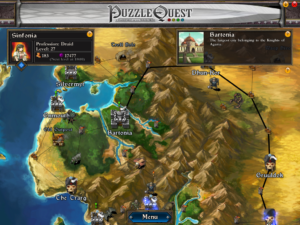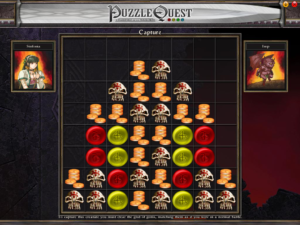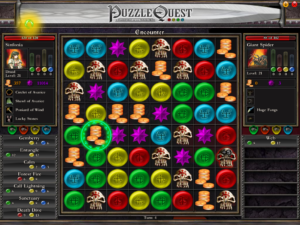Puzzle Quest: Lord Bane
After all the side-quests were done, I had two options for the end: enter Lord Bane’s citadel, or follow my sword as the necromancers instructed. I did go so far as to try the latter, but when you do so, you get some dire warnings from Princess Serephine (who threatens to leave you if you continue on that course) and a final opportunity to chicken out, which I took. I may play through again with another character class, and if I do I’ll definitely want to give the alternate ending a look. But for now, Bartonia is safe.
Beating Lord Bane took me five tries, with various different collections of stuff, including some items I forged specifically for this fight. Lord Bane’s basic trick is that he casts spells that make him more powerful. For each element, he has a spell that destroys all of that element on the board and increases his mastery of that element by the number of gems destroyed, and in addition, his equipment makes his elemental masteries benefit him in other ways. The biggest problem, in my opinion, is his shield, which gives him +1 to all resistances for every 3 points of Earth mastery. So if you let him get enough Earth mastery, your spells start fizzling more and more. As I see it, there are three things you can do to overcome this. First, you can do what you can to hurt him with spells at the beginning of the fight, before he can resist it. Second, you can try to forestall his resistance by having high earth resistance yourself (to keep him from casting the spell that raises his earth mastery) and by using up the green gems on the board before he gets them. Third, you can increase the damage you do when matching skulls so that you’re less dependent on spells to kill him.
Here’s the combination of equipment that ultimately worked for me:
- Spells: Channel Air, Entangle, Forest Fire, Sanctuary, Lightning Storm, Charge!
- Equipment: Quartz Relic (+5 damage for each full mana reserve, +8 Air Resistance), Armor of Minogoth (prevents 1 point of damage when you receive 2 or more, +15 Earth Resistance), Deep Edge (+6 damage when you do 6 or more damage, +8 Earth Resistance), Frozen Harp (+4 to all mana reserves when you match 4 or 5, +8 Fire Resistance)
- Mount: a level 8 Wyvern (Rend spell, +6 to Battle skill)
By this point, I had enough Battle skill that just matching three skulls did 6 damage, and thus triggered the Deep Edge bonus. Like I said, I wanted Earth resistance more than any other kind, but this loadout provides a certain amount of resistance in all elements (water resistance being provided by one of the companions). As for the spells, I basically didn’t use Sancutary (adds to your resistance in a randomly-chosen element) at all, and would have swapped it out for something else if I had to give the fight another try. The most useful spells were Entangle and Charge!, both good for setting up moves; if you can get a foursome out of them, they can almost pay for themselves, given the effect of the Harp. Charge! is notable in that it takes advantage of the board in ways that Lord Bane can’t, so it’s relatively safe to cast when he has high resistance: you lose an opportunity, but at least that opportunity can’t be used against you. In the end, despite Lord Bane’s increased resistance, I struck the final blow with the direct-damage spell Forest Fire.
All in all, this was a satisfying game. Tile-matching games provide one of the purest experiences of flow, and RPGs, with their promises of greater power if you keep leveling, provide buckets of player motivation even when the gameplay isn’t particularly compelling, so it’s a winning combination. And on top of that, it has excellent production values. I haven’t even mentioned the sound: cascades involve one of the best thunderclap sounds I’ve heard in a game, and the background music has prominent bassoon solos. (Or possibly english horn. It can be hard to tell sometimes. Regardless, it’s a good thing.) I understand there’s a sequel due out soon, with a sci-fi setting and hexagonal tiles. I’ll definitely be playing that when it’s released for PC, which will probably happen months after it’s released for everything else.
 Comments(2)
Comments(2)

